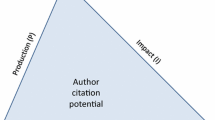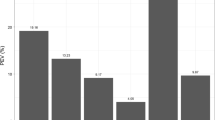Abstract
Quantitative assessment of information production processes requires the definition of a robust citation performance indicator. This is particularly so where there is a need to introduce a normalization mechanism for correcting for quality across field and disciplines. In this paper, we offer insights from the “thermodynamic” approach in terms of quality, quantity and quasity and energy, exergy and entropy to show how the recently introduced expected value measure can be rationalized and improved. The normalized energy indicator E is proposed as a suitable single number scalar indicator of a scientist’s or group’s performance (i.e. as a multiplicative product of quality and quantity), when complete bibliometric information is available.
Similar content being viewed by others
References
Bornmann, L. (2010). Towards an ideal method of measuring research performance: Some comments to the Opthof and Leydesdorff (2010) paper. Journal of Informetrics, 4(3), 441–443.
Bornmann, L., & Mutz, R. (2011). Further steps towards an ideal method of measuring citation performance: The avoidance of citation (ratio) averages in field-normalization. Journal of Informetrics, 5(1), 228–230.
Bornmann, L., de Moya-Anegón, F., & Leydesdorff, L. (2010). Do scientific advancements lean on the shoulders of giants? A bibliometric investigation of the Ortega hypothesis. PLoS One, 5(10), e11344.
Campbell, D., Archambault, E., & Coˆte’, G. (2008). Benchmarking of Canadian Genomics—1996–2007. http://www.science-metrix.com/pdf/SM_Benchmarking_Genomics_Canada.pdf.
Gingras, Y., & Lariviere, V. (2011). There are neither ‘‘king’’ nor ‘‘crown’’ in scientometrics: Comments on a supposed ‘‘alternative’’ method of normalization. Journal of Informetrics, 5(1), 226–227.
Leydesdorff, L., & Bornmann, L. (2011). Integrated impact indicators (I3) compared with Impact Factors (IFs): An alternative design with policy implications. Journal of the American Society for Information Science and Technology. doi: 10.1002/asi.21609.
Leydesdorff, L., & Opthof, T. (2010). Normalization at the field level: Fractional counting of citations. Journal of Informetrics, 4(4), 644–646.
Leydesdorff, L., & Opthof, T. (2011). Remaining problems with the ‘‘new crown indicator’’ (MNCS) of the CWTS. Journal of Informetrics, 5(1), 224–225.
Leydesdorff, L., Bornmann, L., Mutz, R., & Opthof, T. (2011). Turning the tables in citation analysis one more time: Principles for comparing sets of documents. Journal of the American Society for Information Science and Technology, 62(7), 1370–1381.
Lundberg, J. (2007). Lifting the crown—citation z-score. Journal of Informetrics, 1(2), 145–154.
Moed, H. F. (2010). CWTS crown indicator measures citation impact of a research group’s publication oeuvre. Journal of Informetrics, 4(3), 436–438.
National Science Board. (2010). Science and engineering indicators 2010, appendix tables. Arlington, VA, USA: National Science Foundation (NSB 10-01).
Opthof, T., & Leydesdorff, L. (2010). Caveats for the journal and field normalizations in the CWTS (‘‘Leiden’’) evaluations of research performance. Journal of Informetrics, 4(3), 423–430.
Prathap, G. (2011a). The Energy–Exergy–Entropy (or EEE) sequences in bibliometric assessment. Scientometrics, 87, 515–524.
Prathap, G. (2011b). Quasity, when quantity has a quality all of its own—toward a theory of performance. Scientometrics, 88, 555–562.
Rehn, C., & Kronman, U. (2008). Bibliometric handbook for Karolinska Institutet. http://ki.se/content/1/c6/01/79/31/bibliometric_handbook_karolinska_institutet_v_1.05.pdf.
Schubert, A., & Braun, T. (1986). Relative indicators and relational charts for comparative assessment of publication output and citation impact. Scientometrics, 9(5), 281–291.
Spaan, J. A. E. (2010). The danger of pseudoscience in Informetrics. Journal of Informetrics, 4(3), 439–440.
Van Raan, A. F. J., Van Leeuwen, T. N., Visser, M. S., Van Eck, N. J., & Waltman, L. (2010). Rivals for the crown: Reply to Opthof and Leydesdorff. Journal of Informetrics, 4(3), 431–435.
Waltman, L., Van Eck, N. J., Van Leeuwen, T. N., Visser, M. S., & Van Raan, A. F. J. (2011a). Towards a new crown indicator: an empirical analysis. Scientometrics, doi: 10.1007/s11192-011-0354-5.
Waltman, L., Van Eck, N. J., Van Leeuwen, T. N., Visser, M. S., & Van Raan, A. F. J. (2011b). Towards a new crown indicator: Some theoretical considerations. Journal of Informetrics, 5(1), 37–47.
Author information
Authors and Affiliations
Corresponding author
Rights and permissions
About this article
Cite this article
Prathap, G. The quality-quantity-quasity and energy-exergy-entropy exegesis of expected value calculation of citation performance. Scientometrics 91, 269–275 (2012). https://doi.org/10.1007/s11192-011-0516-5
Received:
Published:
Issue Date:
DOI: https://doi.org/10.1007/s11192-011-0516-5




